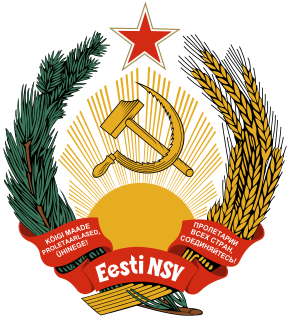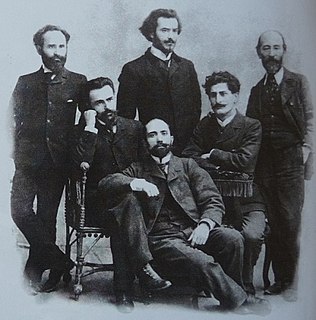
Shachtmanism is the form of Marxism associated with Max Shachtman (1904–1972). It has two major components: a bureaucratic collectivist analysis of the Soviet Union and a third camp approach to world politics. Shachtmanites believe that the Stalinist rulers of proclaimed socialist countries are a new ruling class distinct from the workers and reject Trotsky's description of Stalinist Russia as a "degenerated workers' state".

Konstantin Päts was the most influential politician of interwar Estonia, and served five times as the country's head of government. He was one of the first Estonians to become active in politics and started an almost 40-year political rivalry with Jaan Tõnisson, first through journalism with his newspaper Teataja, later through politics. He was condemned to death during the 1905 Revolution, but managed to flee first to Switzerland, then to Finland, where he continued his literary work. He returned to Estonia, but had to spend time in prison in 1910–1911.

The Soviet westward offensive of 1918–1919 was part of the campaign by the Russian Soviet Federative Socialist Republic into areas abandoned by the Ober Ost garrisons that were being withdrawn to Germany following that country's defeat in World War I. The initially successful offensive against the Republic of Estonia ignited the Estonian War of Independence which ended with the Soviet recognition of Estonia. The war against Republics of Latvia and Lithuania was more successful for the Soviets, and resulted in the Latvian Socialist Soviet Republic and Lithuanian Soviet Socialist Republics being established. In Belarus, the Belarusian People's Republic was conquered and the Socialist Soviet Republic of Byelorussia proclaimed.

Anarchism in Africa refers both to purported anarchic political organisation of some traditional African societies and to modern anarchist movements in Africa.

Vsevolod Mikhailovich Eikhenbaum, known later as Volin or Voline (Во́лин), was a Russian anarchist who participated in the Russian and Ukrainian Revolutions before being forced into exile by the Bolshevik Party. He was a proponent of the anarchist organizational form known as synthesis anarchism.
Anarchism in China was a strong intellectual force in the reform and revolutionary movements in the early 20th century. In the years before and just after the overthrow of the Qing dynasty Chinese anarchists insisted that a true revolution could not be political, replacing one government with another, but had to overthrow traditional culture and create new social practices, especially in the family. "Anarchism" was translated into Chinese as 無政府主義 literally, "the doctrine of no government."

The Communist Party of Estonia was a political party in Estonia.
Anarchist Communist Youth Association of Narva was a political youth movement in Narva, Estonia, at the time of the October Revolution. It operated under the leadership of anarchists. Political meetings and demonstrations were held by the association. They also established a library, several autonomous groups, a choir and a string orchestra. On the initiative of the Tallinn Social Democratic Youth Association, on February 17, 1918, a congress of all social democratic youth organizations operating in Estonia was convened in Tallinn, where a central all-Estonian youth association was to be established. Their 20 delegates represented more than 2,000 members. The Congress had a heated discussion with the anarchist delegates of Narva, who did not agree that the nationwide organization to be established should adopt a Bolshevik program as the beginning of its activities. However, when the program was adopted by a majority, the representatives of the Narva youth left the congress.
Anarchism in Russia has its roots in the early mutual aid systems of the medieval republics and later in the popular resistance to the Tsarist autocracy and serfdom. Through the history of radicalism during the early 19th-century, anarchism developed out of the populist and nihilist movements' dissatisfaction with the government reforms of the time.

The Treaty of Tartu is a peace treaty signed on 2 February 1920 between Estonia and the Russian Soviet Federative Socialist Republic, ending the Estonian War of Independence. The terms of the treaty stated: "In consequence of the right of all peoples to self-determination, to the point of seceding completely from the State of which they form part, a right proclaimed by the Socialist and Federal Russian Republic of the Soviets, Russia unreservedly recognizes the independence and sovereignty of the State of Estonia, and renounces voluntarily and forever all sovereign rights possessed by Russia over the Estonian people and territory whether these rights be based on the juridical position that formerly existed in public law, or in the international treaties which, in the sense here indicated, lose their validity in future." Ratifications of the treaty were exchanged in Moscow on 30 March 1920. It was registered in League of Nations Treaty Series on 12 July 1922.

Anarchism in Ireland has its roots in the stateless organisation of the túatha in Gaelic Ireland. It first began to emerge from the libertarian socialist tendencies within the Irish republican movement, with anarchist individuals and organisations sprouting out of the resurgent socialist movement during the 1880s, particularly gaining prominence during the time of the Dublin Socialist League.
Congress of Estonia was an innovative grassroots parliament established in Estonia as a part of the process of regaining of independence from the Soviet Union. It also challenged the power and authority of the pre-existing quasi-parliament in the country, called the Supreme Soviet of the Estonian SSR, which had been imposed on Estonia after Moscow's illegal annexation in 1940. The Congress of Estonia declared that it represented the highest authority on questions of Estonian statehood and citizenship, deriving this authority from the consent and initiative of the citizens of Estonia. The aim of the Congress was to restore Estonian independence based on the principle of legal continuity, with the pre-1940 republic of Estonia, which had been established in 1918, as the foundation.

The following is an alphabetical list of articles related to the Republic of Estonia.

Anarchism in Georgia began to emerge during the late 19th-century out of the Georgian national liberation movement and the Russian nihilist movement. It reached its apex during the 1905 Russian Revolution, after a number of anarchists returned from exile to participate in revolutionary activities, such as in the newly-established Gurian Republic.

Anarchism in Indonesia has its roots in the anti-colonial struggle against the Dutch Empire. It became an organized movement at the behest of Chinese anarchist immigrants, who played a key part in the development of the workers' movement in the country. The anarchist movement was suppressed, first by the Japanese occupation of Indonesia, then by the successive regimes of Sukarno and Suharto, before finally re-emerging in the 1990s.
Anarchism in the Philippines has its roots in the anti-colonial struggle against the Spanish Empire, becoming influential in the Philippine Revolution and the country's early trade unionist movement. After being supplanted by Marxism-Leninism as the leading revolutionary tendency during the mid-20th century, it experienced a resurgence as part of the punk subculture, following the fragmentation of the Communist Party of the Philippines.
Anarchism in Hungary emerged from the social democratic movement in the late 19th century, coming to play a prominent role in the anti-militarist movement during World War I and in the subsequent revolution that culminated in the Hungarian Soviet Republic. The anarchist movement was then repressed by the Horthy regime, before re-emerging as part of the anti-fascist resistance movement during World War II. This second wave of anarchism was also repressed, this time by the newly established communist regime. Anarchist ideas were briefly expressed during the Hungarian Revolution of 1956 but remained largely suppressed until the fall of socialism, which gave way to a third wave of anarchism in Hungary.
Anarchism in Denmark emerged in the late 19th century from the revolutionary factions of early social democratic spheres, crystalizing into a widespread anarcho-syndicalist movement that reached its height during the late 1910s. After the disintegration of organized syndicalism, anarchists in post-war Denmark began to organize the squatters' movement, which led to the creation of Freetown Christiania.
Anarchism in Latvia emerged from the Latvian National Awakening and saw its apex during the 1905 Russian Revolution. Eventually the Latvian anarchist movement was suppressed by a series of authoritarian regimes in the country.
Anarchism in Austria first developed from the anarchist segments of the International Workingmen's Association (IWA), eventually growing into a nationwide anarcho-syndicalist movement that reached its height during the 1920s. Following the institution of fascism in Austria and the subsequent war, the anarchist movement was slow to recover, eventually reconstituting anarcho-syndicalism by the 1990s.











